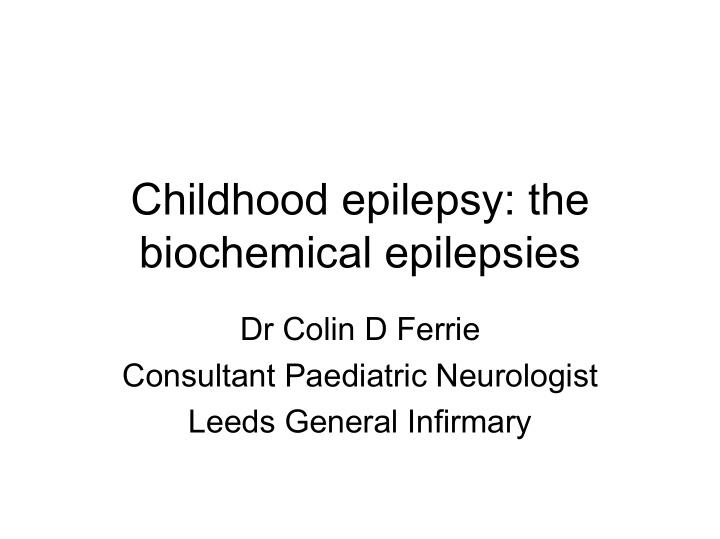



Childhood epilepsy: the biochemical epilepsies Dr Colin D Ferrie Consultant Paediatric Neurologist Leeds General Infirmary
Definitions • Epileptic Seizure – Manifestation(s) of epileptic (excessive and/or hypersynchronous), usually self-limited activity of neurones in the brain • Epilepsy – A chronic neurological condition characterised by recurrent epileptic seizures • Epilepsy Syndrome – A complex of signs and symptoms which define a unique epilepsy condition • Epileptic Disease – A pathologic condition with a single, specific, well- defined aetiology
Epidemiology
Classification: The ILAE Diagnostic Scheme • Axis 1 – A Glossary of terms • Axis 2 – Epileptic Seizures • Axis 3 – Epilepsies and Epileptic Syndromes • Axis 4 – Aetiology • Axis 5 – Functional Consequences
What Causes Epilepsy in Children? • Ion channel disorders • Malformations of cortical development • Neurocutaneous disorders • Chromosomal and monogenic mendelian disorders • Pre, peri and postnatal destructive processes (ischaemic, anoxic, infections, trauma, etc) • Tumours • Inherited metabolic disorders (including the progressive myoclonic epilepsies) - ‘the biochemical epilepsies’
These are all very rare! Inborn error of metabolism Epilepsy
‘Biochemical’ seizure disorders with neonatal onset Reasons to suspect – Family history • Most are recessive conditions – In-utero hiccups • Some cause seizures in-utero – Myoclonic seizures • Myoclonic seizures occur in many types of epilepsy, but are particularly characteristic of ‘biochemical seizure disorders’ – Intractable seizures • Most do not respond at all or at all well to conventional AEDs – Associated encephalopathy • Beware HIE – Dysmorphic features • E.g. Zellwegar’s syndrome – Burst-supression EEG
‘Biochemical’ seizure disorders with neonatal onset • Vitamin dependent seizures – Pyridoxine dependency – Pyridoxal phosphate dependency – Folinic acid responsive seizures • Amino acid disorders, including neurotransmitter abnormalities – GABA transaminase deficiency – Non-ketotic hyperglycinaemia (glycine encephalopathy) – Sulfite oxidase deficiency & molybdenum cofactor deficiency • Urea cycle disorders • Organicacidurias • Aminoacidurias • Mitochondrial disorders • Peroxisomal disorders
Pyridoxine dependent seizures • Classically begins in very early neonatal period with drug resistant convulsive seizures ± encephalopathy • In-utero onset well recognised • Onset may be up to 3 years of age with a variable seizure phenotype • Need to distinguish pyridoxine responsive and pyridoxine dependent seizures • Outcome highly variable
Pyridoxine dependent seizures GAD GABA-T Succinic Glutamate GABA semialdehyde B 6 B 6 Mutations in the ALDH7A1 gene (5q31) which codes for antiquitin is the cause of pyridoxine dependent seizures. Abolition of antiquitin activity eventually leads to inactivation of pyridoxal 5’-P Diagnosis can now be established by urinary measurement of α -AASA Prenatal diagnosis can be made by ALDH7A1 gene analysis
Pyridoxal 5’ phosphate dependent seizures GAD GABA-T Succinic Glutamate GABA semialdehyde B 6 B 6 Pyridoxal 5’-P is the active form of pyridoxine and is formed from pyridoxine by the activity of the enzyme PNPO Deficiency of PNPO causes pyridoxal phosphate dependent seizures The diagnosis is aided by CSF neurotransmitter analysis [aromatic L-amino acid decarboxylase (AADC) deficiency]
Folinic acid responsive seizures Clinical Features: •Intractable neonatal seizures •May be associated encephalopathy Diagnosis: Treatment: •CSF chromatography •Oral folinic acid •Trial of folinic acid
GABA transaminase deficiency GAD GABA-T Succinic Glutamate GABA semialdehyde B 6 B 6 GABA transaminase (GABA-T) deficiency is exceptionally rare Seizures are associated with severe retardation and increased somatic growth (including megalencephaly) GABA and various metabolites are increased in plasma and other body fluids
Glycine encephalopathy • Characteristicaly leads to early myoclonic encephalopathy Caused by disorders of the glycine cleavage system, leading to accumulation of glycine in various body fluids Prenatal diagnosis is possible enzymatically or genetically
Sulfite oxidase deficiency & molybdenum cofactor deficiency (MCD) • Sulfite oxidase deficiency can be a single enzyme deficiency or part of deficiency of the molybdenum cofactor-containing enzymes • In either case: – Autosomal recessive – Severe & irreversible brain damage from birth resembling HIE – Intractable neonatal seizures Diagnosis: •Sulfituria by dipstix •Accumulation of thiosulfate, S-sulfocysteine and taurine in plasma and urine (chromatography) •MCD is also associated with hypouricaemia and xanthiuria •Enzyme activities on cultured fibroblasts
‘Biochemical’ seizure disorders with onset in infancy, childhood and adolescence • Biotinidase deficiency • Glut-1 deficiency • Serine synthesis disorders • Creatine synthesis disorders • Some of the progressive myoclonic epilepsies – Myoclonic epilepsy with ragged red fibres (MERRF) – Ceroid lipofuscinoses – Sialidoses
Biotinidase deficiency • Biotin is a vitamin essential for the function of four carboxylase enzymes involved in diverse areas of intermediary metabolism • Biotinidase is an enzyme responsible for recycling of biotin Clinical Features: Diagnosis: •Autosomal recessive •Urinary organic acids •Alopecia & dermatitis •Serum biotinidase •Fatigue, hypotonia & lethargy Coma •Ataxia Treatment: •Seizures (esp myoclonic) •Oral biotin
Glut-1 Deficiency Clinical features: •Refractory seizures (GTCS; absence; others) Blood Brain •Apnoeas •Abnormal eye movements •Developmental delay & acquired Glucose microcephaly Diagnosis: •Low [CSF] glucose :[blood] glucose •Glut-1 transporter functional assay in erythrocytes •GLUT-1 mutational analysis Treatment: = glucose transporter •Ketogenic diet
Serine Biosynthesis Disorders Clinical features: •Congenital microcephaly & Glycolysis severe retardation •Seizures 3-phosphoglycerate •Polyneuropathy dehydrogenase Diagnosis: Low fasting CSF [serine] Serine Treatment: Glycine •Oral serine supplementation
The biochemical epilepsies: summary 1 Biochemical Biochemical test treatment Pyridoxine dependent ± √ seizures Pyridoxal P dependent ± √ seizures Folinic acid responsive ± √ seizures GABA transaminase √ X deficiency Non-ketotic √ X hyperglycinaemia Sulfite oxidase & √ X molybdenum cofactor deficiencies
The biochemical epilepsies: summary 2 Biochemical Biochemical test treatment Biotinidase deficiency √ √ Glut – 1 deficiency √ √ Serine synthesis √ √ disorders Creatine synthesis √ √ disorders Progressive myoclonic ± X epilepsies
Recommend
More recommend